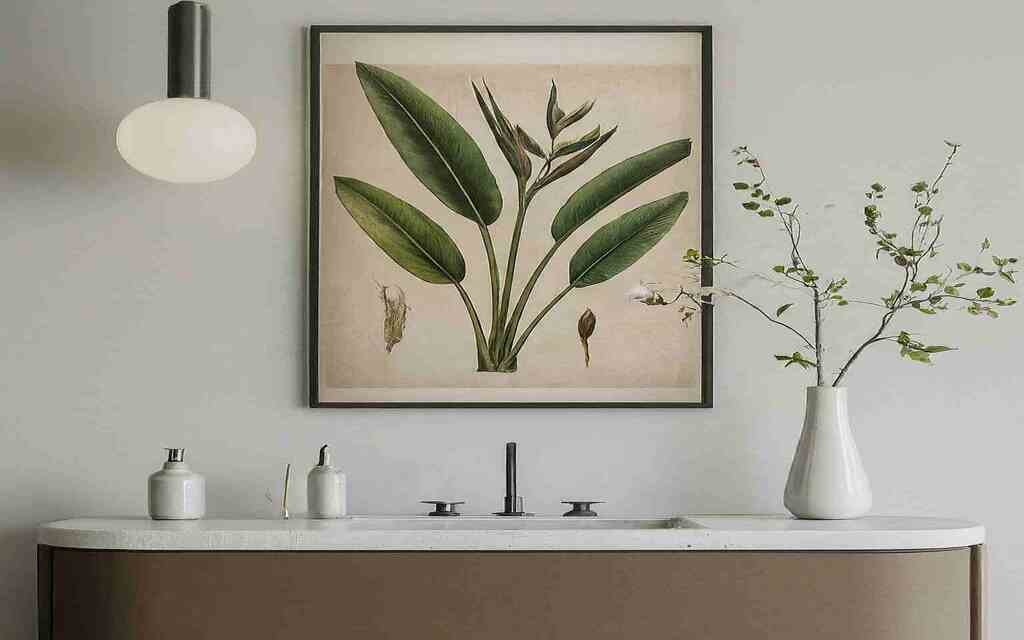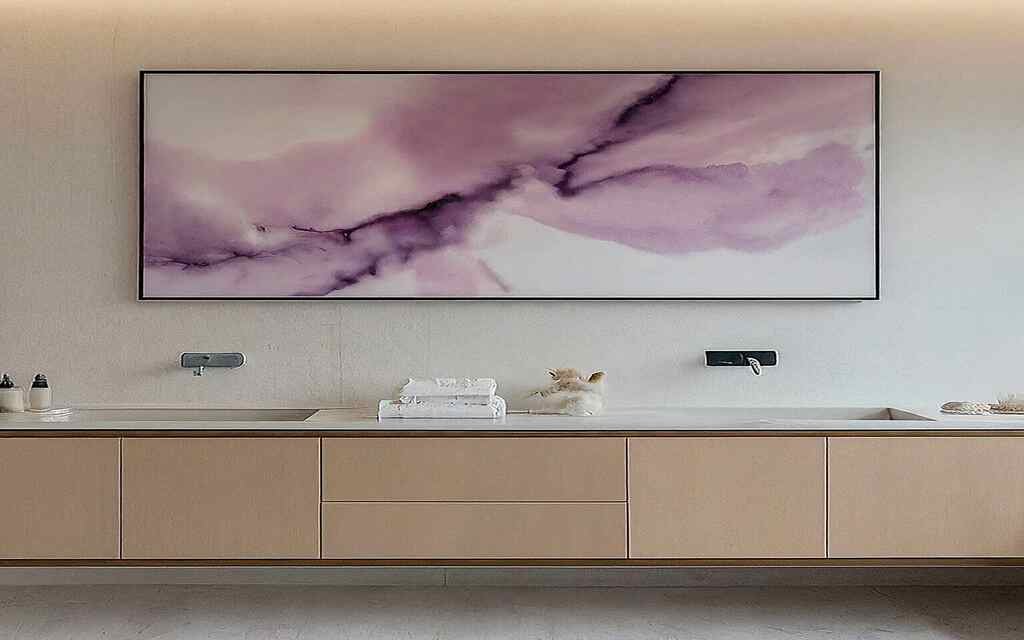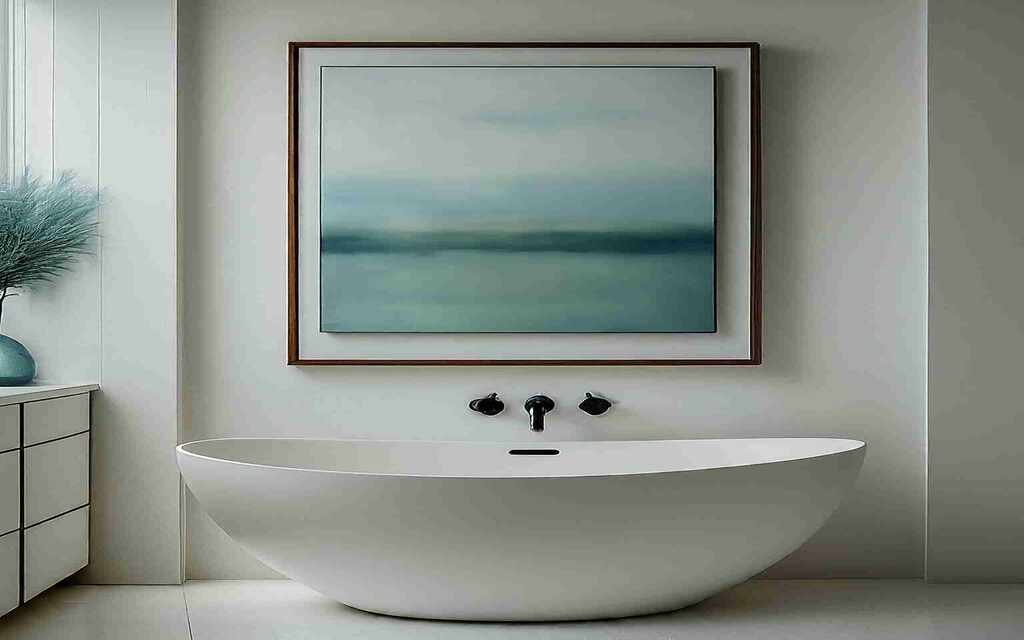The bathroom: a sanctuary for relaxation and rejuvenation. But that steamy shower you love can wreak havoc on your paint job if you’re not prepared for it.
Unlike other rooms in the house, bathrooms face a constant battle against moisture and humidity, leading to peeling paint, unsightly mildew growth, and a whole lot of frustration.

Fear not, bathroom renovation warriors! This Best Paint for Bathrooms comprehensive guide will equip you with the knowledge to navigate the paint aisle with confidence and choose the perfect paint to shield your bathroom from the elements and keep it looking fresh and serene.
Table of Contents
Key Points: For the Best Paint for Bathrooms
| Factor | Description |
|---|---|
| Moisture is the Enemy | Regular paint won’t hold up against the constant moisture and humidity in bathrooms, leading to peeling and mold growth. |
| Choose Moisture-Resistant Paint | * Latex with mildewcide: Most areas * Epoxy paint: High-splash zones (shower surrounds) |
| Sheen Matters | Gloss and semi-gloss finishes are best for easy cleaning due to water-repellent properties. |
| Flat/Matte Options Exist | Look for bathroom-specific flat/matte paints for better moisture resistance and easier cleaning. |
| Prime for Success | Use a bathroom-specific primer for a strong bond between paint and wall, and added mildew protection. |
| Ventilation is Key | Proper ventilation helps reduce moisture build-up and prevent mold growth. |
Understanding the Enemy: Moisture and Why Regular Paint Won’t Do
Regular interior paint simply isn’t built for the constant moisture assault a bathroom endures. The high humidity levels cause the paint to break down, leading to peeling and bubbling.
This not only creates an unsightly mess but also exposes the underlying wall material to further moisture damage. Additionally, moisture provides a breeding ground for mold and mildew, those unwelcome guests that can pose health risks and leave unsightly stains.
The Heroes of the Story: Moisture-Resistant Paints
To conquer the moisture monster, you need paint specifically designed for bathrooms. These paints come in two main varieties, each with its strengths:
- Latex-based paint with mildewcide: This is a popular and affordable choice for most bathroom walls and ceilings. Latex paint offers good moisture resistance, and the added mildewcide helps prevent the growth of mold and mildew spores. It’s also water-based, making cleanup after application a breeze.
- Epoxy paint: The ultimate moisture-resistant champion. Epoxy paint creates an extremely durable, hard finish that’s ideal for high-moisture areas like shower surrounds, countertops, and even floors.
- It’s exceptionally resistant to water, chemicals, and mold growth. However, epoxy paint is more expensive than latex and requires more surface preparation due to its strong fumes and two-part system (resin and hardener).
Best Paint for Bathrooms and their types
| Paint Type | Pros | Cons | Ideal for |
|---|---|---|---|
| Latex-based with Mildewcide | * Affordable * Easier application (water-based) * Wider variety of colors * Breathable (allows some moisture vapor to escape) | * Less durable than epoxy * Requires more frequent touch-ups * Not ideal for areas with constant water exposure (shower surround) * May not be as stain-resistant | Walls, ceilings, vanities |
| Epoxy Paint | * Superior moisture resistance * Creates a very durable, hard finish * Excellent chemical resistance * Mold and mildew resistant | * More expensive * Requires more surface preparation (strong fumes) * Difficult to apply (two-part system) * Less breathable (can trap moisture if ventilation isn’t ideal) | Floors, shower surrounds, countertops |

Choosing the Right Finish: A Matter of Sheen
Paint finish, also known as sheen, plays a crucial role in both the aesthetics and functionality of your bathroom paint. Here’s a breakdown of the two most recommended finishes for bathrooms:
- Gloss and Semi-Gloss: These finishes are moisture-resistant superstars. They create a hard, non-porous surface that repels water, making them ideal for areas prone to splashes and splatters.
- Gloss offers the most protection but can highlight imperfections on walls. Opt for this finish for trim, doors, and cabinets for a touch of elegance and easy cleaning. Semi-gloss provides a softer sheen that’s still easy to wipe down and is a versatile choice for both walls and trim.
Paint Finishes for Bathrooms
| Sheen Level | Finish Name | Pros | Cons | Ideal for |
|---|---|---|---|---|
| High Shine | Gloss | * Excellent cleanability (wipes down easily) * Durable and stain-resistant * Creates a bright and airy feel * Can hide minor imperfections on trim | * Highlights imperfections on walls * Can show brushstrokes more readily * Slippery surface may not be ideal for all trim * May show water spots more easily | Trim, doors, cabinets |
| Low Sheen | , | * Easier to hide imperfections on walls * More forgiving sheen * Offers a more elegant and sophisticated look * Good balance of cleanability and washability | * Not as cleanable as gloss * Lower stain resistance | Walls and ceilings, bathrooms with moderate moisture |
Can I Use Flat or Matte Paint?
Traditionally, flat and matte finishes were a no-go in bathrooms due to their susceptibility to moisture damage and difficulty cleaning. However, advancements in paint technology have given rise to flat and matte paints specifically formulated for bathrooms.
These paints offer better moisture resistance and easier cleaning compared to their traditional counterparts. Look for labels like “bathroom paint” or “mold and mildew resistant” if you prefer a low-sheen look for your walls.
Beyond Paint: Priming for Success
A strong foundation is key for any successful paint job, and the bathroom is no exception. Using a primer specifically designed for bathrooms creates a strong bond between the paint and the wall, preventing peeling and protecting your paint job for years to come.
Additionally, many primers contain mildewcide additives, providing an extra layer of defense against mold and mildew growth.
Let’s Talk Color: Setting the Mood
While this guide focuses on paint type and finish, choosing the right color is an important part of creating your dream bathroom. Lighter colors like white or soft neutrals will reflect light and make your bathroom feel more spacious and airy.
These colors are also great for small bathrooms. If you have a larger bathroom and want to add a touch of personality, consider bolder colors for the cabinets or a single accent wall.
Additional Considerations for Bathroom Paint
| Factor | Description |
|---|---|
| Ventilation | Proper ventilation is crucial in bathrooms to reduce moisture build-up and prevent mold growth. Ensure your bathroom has a functioning exhaust fan and consider opening a window after showering to allow moisture to escape. |
| DIY Expertise | If you’re a DIY novice, latex paint with a mildewcide additive might be a better choice than epoxy due to its easier application and cleanup. Epoxy requires more experience and proper ventilation due to strong fumes. |
| Hardware Must-Haves | For bathroom fixtures and hardware, opt for rust-resistant paints. Consider using a lacquer topcoat for extra protection against moisture and wear and tear. |
- Ventilation is Vital: Proper ventilation is crucial in bathrooms to reduce moisture build-up and prevent mold growth.
- Ensure your bathroom has a functioning exhaust fan and consider opening a window after showering to allow moisture to escape.
- DIY Expertise Matters: If you’re a DIY novice, latex paint with a mildewcide additive might be a better choice than epoxy due to its easier application and cleanup. Epoxy requires more experience and proper ventilation due to strong fumes.
- Hardware Must-Haves: For bathroom fixtures and hardware, opt for rust-resistant paints. Consider using a lacquer topcoat for extra protection against moisture and wear and tear.
Conclusion: Breathe Easy and Relax in a Beautifully Painted Bathroom
Bathrooms are a haven for relaxation and self-care, but the constant moisture can wreak havoc on a paint job. By understanding the challenges and choosing the right moisture-resistant paint, finish, and primer, you can create a beautiful and functional bathroom that will withstand the test of time (and steam!).
Remember, the key is to fight moisture with the right weapons. Opt for latex paint with mildewcide for most areas, or epoxy paint for high-moisture zones. Embrace the easy cleaning power of gloss or semi-gloss finishes on walls and trim.
Don’t be afraid of flat or matte paints if you prefer a low-sheen look, as long as they’re formulated for bathrooms. And lastly, never underestimate the power of a good primer to create a lasting bond and extra protection.
With the knowledge you’ve gained from this guide, you can conquer bathroom humidity and create a bathroom that’s both beautiful and built to last. So grab your paintbrush, breathe easy, and get ready to relax in your newly transformed bathroom retreat!
FAQ: Conquering Bathroom Humidity with the Perfect Paint
Q: Can I use regular interior paint in my bathroom?
A: No, regular interior paint is not designed for the high moisture levels in bathrooms and will likely peel or develop mold. Choose paint specifically formulated for bathrooms with moisture resistance and mildewcide properties.
Q: What’s the difference between latex and epoxy paint for bathrooms?
A: Latex paint with mildewcide is more affordable, easier to apply, and comes in a wider variety of colors. However, it’s less durable and not ideal for areas with constant water exposure. Epoxy paint offers superior moisture resistance and durability but is more expensive, requires more surface prep, and has stronger fumes.
Q: What paint finish is best for bathroom walls?
A: Satin and semi-gloss finishes are most recommended for bathroom walls. They offer a good balance of cleanability, moisture resistance, and the ability to hide imperfections. Flat or matte paints specifically designed for bathrooms can also be used if you prefer a low-sheen look.
Q: Do I need a primer before painting my bathroom?
A: Yes, using a primer specifically designed for bathrooms is highly recommended. It creates a strong bond between the paint and the wall, prevents peeling, and often contains mildewcide for added protection.
Q: How can I improve ventilation in my bathroom?
A: Ensure your bathroom has a functioning exhaust fan and turn it on during showers and baths. Consider opening a window after showering to allow moisture to escape
